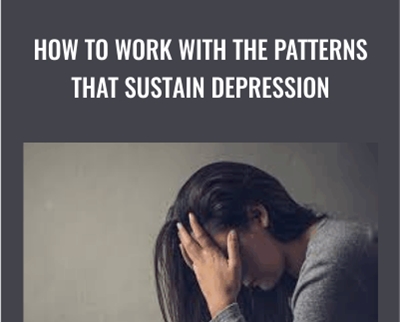How to Work with the Patterns That Sustain Depression – NICABM
Original price was: $197.00.$29.00Current price is: $29.00.
How to Work with the Patterns That Sustain Depression – NICABM Download. Depression can overwhelm a client’s life and rob them of meaning, joy and a sense …
Salepage link: At HERE. Archive: http://archive.is/wip/q5vok
Overcoming Barriers to Healing Depression
How to Disrupt the Patterns That Sustain Your Client’s Depression
Depression can overwhelm a client’s life and rob them of meaning, joy and a sense of value.
Left untreated, it can feel like a life sentence – like nothing will ever change.
So to successfully treat depression, we have to look at the issues that sustain it.
First, we have to look at low motivation, because without motivation it’s hard for a client to take any action, and lack of action can often foster feelings of shame.
Beyond that, we also need to break up the two critical thought patterns that can leave clients defenseless against depression’s power.
Trauma also plays a role in depression, and we need to look at the way it can trick the mind into shutdown.
15 top thought leaders shared their personal insights and strategies for working with depression and reducing relapse. We put all their practical ideas together into a brand-new program . . .
Brand New Short Course
How to Work with the Patterns That Sustain Depression
How to Work with Toxic Self-Narratives That Sustain Depression
Marsha Linehan, PhD
- A practical depression strategy for working with a client’s feeling of “nobody likes me”
- One way to break the harsh self-narrative that drives a client into depression
- How to help clients escape depression when their critical thoughts are based on a truth
How to Disrupt the Low Motivation Driving a Client’s Depression
Shelly Harrell, PhD Kelly McGonigal, PhD
- Why low motivation can often trap a client in shame
- Two aspects of low motivation that can sustain a client’s depression
Key Strategies to Disrupt Trauma-Driven Depression
Pat Ogden, PhD
- How the dorsal-vagal system can hold a client hostage to depression
- Why it’s vital to address both the body and the nervous system to correct a depression posture
- How to unhook the emotional trigger that sets off a depression response in the body
Critical Skills to Help Clients Avoid Depression Relapse
Christine Padesky, PhD Rick Hanson, PhD Bill O’Hanlon, LMFT
- Why your relapse plan could be the most critical part of therapy
- Two essential antidepressant skills that can significantly reduce depression relapse
- An important part of depression treatment that helps the client know when to activate their relapse plan
How to Break the Depression-Rigid-Thinking Loop
Lynn Lyons, LICSW Kelly McGonigal, PhD Rick Hanson, PhD
- The small language change that can break a client’s rigid depressive thought
- Why some clients with depression are more willing to talk about feelings (and the big reason you might want to avoid doing this)
How to Keep a Client’s Low Motivation From Sabotaging Treatment
Richard Schwartz, PhD Joan Borysenko, PhD
- Two ways depression shows up (and why it’s crucial to work with each one differently)
- The critical first step to prevent a client’s low motivation from sabotaging treatment
- What can go wrong if you focus on a client’s pain before addressing their low motivation
Overcoming Depression After a Major Life Loss
Marsha Linehan, PhD Ron Siegel, PsyD Joan Borysenko, PhD
- How to help clients find effective ways to alter their relationship with depression
- The “grieving pact” that allows clients to suffer while also helping them out of depression
Two Powerful Skills to Reduce a Client’s Depression Risk
Michael Yapko, PhD Kelly McGonigal, PhD
- How to resource clients struggling with depression so they can withstand change
- A common factor in depression treatment that results in higher success rates
- The number one reason a client with depression will leave therapy after the first session
How to Lead the Traumatized Brain Out of Depression
Bessel van der Kolk, MD
- A crucial first step for treating clients who are too shut down to feel any motivation
- How trauma can corrupt the “savings network” of the brain and leave a client more vulnerable to depression
- Why traditional therapy may be ineffective against shutdown patterns linked to depression
Get 3 Bonuses That Give You Even More Strategies for Working with a Client’s Depression
Bonus 1: How to Work with the Patterns That Sustain Depression in Couples (When Only One Person is Depressed)
Stan Tatkin, PsyD, MFT Bill O’Hanlon, LMFT Ron Siegel, PsyD
- One simple way for a person to upregulate their partner’s depressed state
- How the prefrontal cortex keeps a client’s brain bound to depression (and how their partner can disrupt it)
- One change to a couple’s sleep pattern that can help relieve depression
Bonus 2
Part 1: The Patterns That Can Turn Depression Dangerous
Christine Padesky, PhD Ron Siegel, PsyD Joan Borysenko, PhD
- One way to help clients determine if they’re suffering from grief or from depression
- An investigation skill to help clients reverse depressed thoughts
- How to shift a client’s rigid beliefs about their life’s value
- How to help clients assess the most devastating belief that powers their depression
Part 2: Working with a Depressed Client Who is Suicidal
Marsha Linehan, PhD
- One technique to disrupt suicidal patterns of thought and help clients focus more on bettering their life
- How to use missing evidence to help clients step back from thoughts of suicide
- How to shift your approach to a client’s depression when they’re considering suicide
Bonus 3: How to Activate a Client’s Support System to Help Them Beat Depression
Shelly Harrell, PhD Terry Real, MSW, LICSW
Joan Borysenko, PhD Rick Hanson, PhD
- The vital ingredient a partner brings to treatment that makes the healing process so powerful
- The fundamental strategy that can help your most challenging clients commit to depression treatment
- How to empower the partner to stand up to their loved one’s depression while motivating them to change
Here's an overview of the prominent keywords and a list of famous authors:
Business and Sales: Explore business strategies, sales skills, entrepreneurship, and brand-building from authors like Joe Wicks, Jillian Michaels, and Tony Horton.
Sports and Fitness: Enhance athleticism, improve health and fitness with guidance from experts like Shaun T, Kayla Itsines, and Yoga with Adriene.
Personal Development: Develop communication skills, time management, creative thinking, and enhance self-awareness from authors like Gretchen Rubin, Simon Sinek, and Marie Kondo.
Technology and Coding: Learn about artificial intelligence, data analytics, programming, and blockchain technology from thought leaders like Neil deGrasse Tyson, Amy Cuddy, and Malcolm Gladwell.
Lifestyle and Wellness: Discover courses on holistic health, yoga, and healthy living from authors like Elizabeth Gilbert, Bill Nye, and Tracy Anderson.
Art and Creativity: Explore the world of art, creativity, and painting with guidance from renowned artists like Bob Ross and others.
All the courses on WSOlib are led by top authors and experts in their respective fields. Rest assured that the knowledge and skills you acquire are reliable and highly applicable.
Specification: How to Work with the Patterns That Sustain Depression – NICABM
|
User Reviews
Only logged in customers who have purchased this product may leave a review.

Original price was: $197.00.$29.00Current price is: $29.00.












There are no reviews yet.